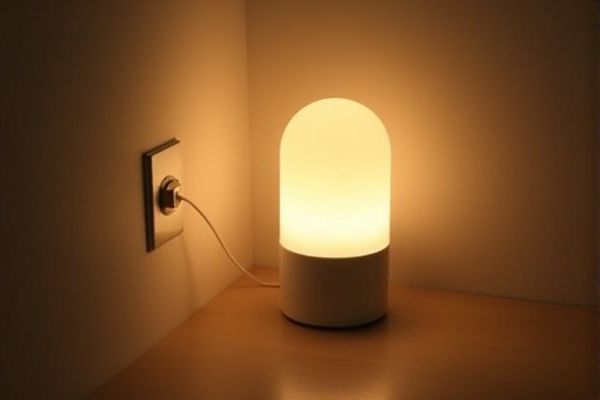
Rechargeable lamps offer portability and convenience without needing constant access to an electrical outlet, making them ideal for outdoor use or during power outages, whereas plug-in lamps provide consistent power and typically emit brighter, steadier light suitable for fixed indoor locations. Understanding the advantages of each type will help You choose the perfect lighting solution for Your needs--read on to explore their features in detail.
Table of Comparison
| Feature | Rechargeable Lamp | Plug-in Lamp |
|---|---|---|
| Power Source | Built-in battery, rechargeable | Direct AC power from outlet |
| Portability | Highly portable and cordless | Fixed location, requires nearby outlet |
| Usage Time | Limited by battery capacity (2-10 hours) | Unlimited while plugged in |
| Setup | No wiring, ready to use after charging | Requires outlet and sometimes installation |
| Energy Efficiency | Depends on battery and LED tech | Consistent power, may consume more energy |
| Maintenance | Battery replacement needed over time | Minimal, mostly bulb replacement |
| Cost | Usually higher upfront due to battery | Generally lower initial cost |
| Ideal Use | Outdoor, emergency, portable lighting | Indoor, fixed-area illumination |
Introduction to Rechargeable and Plug-In Lamps
Rechargeable lamps utilize built-in batteries, allowing portable, cordless illumination ideal for mobility and emergency use. Plug-in lamps rely on a constant electrical connection, providing uninterrupted light without battery limitations but restricting placement due to the need for a power outlet. Choosing between these lamps depends on user preferences for flexibility, power source availability, and intended usage scenarios.
Key Differences Between Rechargeable and Plug-In Lamps
Rechargeable lamps operate on built-in batteries that store energy for cordless use, offering portability and convenience in areas without power outlets. Plug-in lamps rely on continuous electrical power from a wall socket, ensuring consistent brightness but limiting mobility. Your choice depends on whether you prioritize flexibility with rechargeable models or steady illumination from plug-in lamps.
Energy Efficiency Comparison
Rechargeable lamps utilize built-in batteries that store energy for cordless use, significantly reducing electricity consumption compared to plug-in lamps that rely on continuous power supply. Your energy savings increase as rechargeable lamps often use LED technology, which consumes less power and generates less heat. This makes rechargeable lamps a more energy-efficient choice, especially in areas with frequent power outages or for portable lighting needs.
Portability and Placement Flexibility
Rechargeable lamps offer superior portability and placement flexibility compared to plug-in lamps since they operate without the need for a constant power source or nearby outlet. You can easily move rechargeable lamps to different rooms, outdoor areas, or remote locations, making them ideal for camping or emergency use. Plug-in lamps, however, are restricted by the location of electrical outlets, limiting their versatility and convenience in various settings.
Battery Life vs Continuous Power Supply
Rechargeable lamps offer the advantage of portability with limited battery life, typically lasting between 4 to 12 hours per charge depending on the battery capacity and LED efficiency. Plug-in lamps provide a continuous power supply, ensuring uninterrupted lighting without the need for recharging, ideal for extended use. Battery life in rechargeable lamps depends on factors such as battery type (Li-ion or NiMH), wattage, and usage patterns, while plug-in lamps rely on a stable electrical connection for consistent performance.
Cost Analysis: Upfront and Long-Term
Rechargeable lamps typically have a higher upfront cost due to integrated batteries and charging components, but they offer long-term savings by eliminating continuous electricity expenses and reducing the need for replacement bulbs. Plug-in lamps generally require lower initial investment but incur higher ongoing costs due to constant energy consumption and potential frequent bulb replacements. Evaluating total cost of ownership reveals that rechargeable lamps provide better economic value in energy savings and maintenance over extended periods.
Design and Style Options
Rechargeable lamps offer versatile design options with portable, compact shapes ideal for modern, minimalist aesthetics and outdoor use. Plug-in lamps typically feature a wider range of styles, from classic to contemporary, designed for consistent indoor placement and more elaborate fixtures. Your choice depends on the desired balance between portability and decorative variety in your living space.
Safety and Maintenance Considerations
Rechargeable lamps offer enhanced safety due to the absence of direct electrical cords, reducing risks of tripping and electrical shocks, making them ideal for outdoor and emergency use. These lamps require minimal maintenance, primarily involving periodic battery charging and occasional replacement, whereas plug-in lamps depend on continual access to power outlets and may pose hazards from exposed wires or faulty plugs. Regular inspection of rechargeable lamp batteries ensures optimal performance and longevity, while plug-in lamps demand checking cords and sockets for wear and electrical safety.
Eco-Friendliness and Sustainability
Rechargeable lamps significantly reduce environmental impact by eliminating the need for disposable batteries and lowering electricity consumption compared to plug-in lamps. Their reliance on rechargeable lithium-ion or nickel-metal hydride batteries promotes sustainability through extended device lifespan and reduced electronic waste. Plug-in lamps continuously draw power from the grid, often sourced from fossil fuels, whereas rechargeable lamps can be charged using renewable energy sources, enhancing eco-friendliness.
Choosing the Right Lamp for Your Needs
Rechargeable lamps offer portability and cordless convenience, ideal for outdoor use or areas with limited power outlets, while plug-in lamps provide continuous power suitable for stationary settings like offices or home desks. Your choice depends on whether mobility or uninterrupted energy supply is more critical for your daily activities. Consider battery life in rechargeable models versus consistent illumination from plug-in lamps to support your lighting requirements effectively.
 homyna.com
homyna.com